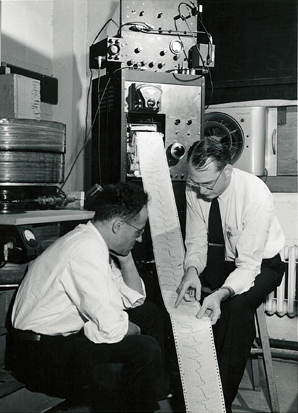June 25 marks the 100th birthday of Samuel “Sam” Issac Weissman, PhD, beloved professor of chemistry at Washington University in St. Louis who died at 94 in 2007.
To recognize the birth 100 years ago of this Manhattan Project scientist and beloved teacher, who developed the technique of electron spin resonance (ESR) to probe the structure of molecules, WUSTL’s Department of Chemistry in Arts & Sciences is hosting a poster session, lecture and symposium Thursday and Friday, May 10 and 11.
The poster session will kick off the festivities at 2:30 p.m. Thursday, May 10 in Room 461, Louderman Hall.
At 4 p.m. the second annual Weissman Lecture will begin in Room 458 in Louderman Hall. Charles Slichter, PhD, emeritus professor of physics at the University of Illinois, will speak on nuclear magnetic resonance, a powerful analytical technique to whose sibling technique ESR made pioneering contributions.
Slichter will describe the burst of creativity that followed the discovery of nuclear magnetic resonance in 1946 and the many uses to which the new technique was put. Invented to study the properties of the nuclei of atoms, it moved first into condensed matter physics, then into chemistry, biology, and lastly into medicine, where it became the basis for Magnetic Resonance Imaging.
The talk is free and open to the public, as is the symposium the following day.
The following day, a scientific symposium will be held in Room 458 Louderman Hall, beginning at 9 a.m. The symposium will be a homecoming for Weissman’s former students, postdocs and friends.
In addition to Slichter and Weissman’s son Michael B. Weissman, PhD, professor emeritus of physics at the University of Illinois at Urbana-Champaign, symposium participants will include faculty from Massachusetts Institute of Technology, Tohoku University in Japan, the Freiberg University in Germany, Stanford University, Missouri University of Science and Technology, Southern Illinois University, Carbondale and Loyola University Chicago.
About Sam Weissman
Weissman’s career is inextricably entwined with the history of the chemistry department and of WUSTL.

This history is elegantly described in the Rettner Gallery of the Lab Sciences Building, where portraits of the six scientists who founded the modern chemistry department hang.
The captions for the portraits were written by Alfred M. Holtzer, PhD, emeritus professor of chemistry, who was a student of five of the six chemists before becoming their fellow scientist and colleague.
Holtzer wrote:
Just after WW II, the Washington University Chemistry Department comprised only three members, none active in research. The Board of Trustees decided to raise the University’s scholarly level to include research as well as teaching. To that end, they appointed physics Nobel Laureate Arthur Holly Compton, a former WU faculty member, as Chancellor. Compton had been an important figure in the Manhattan Project that created the atomic bombs. In 1946, he recruited to WU from the Los Alamos campus of the Manhattan Project, the six chemists whose portraits are hung in this Rettner Gallery.
They brought with them from Los Alamos, not only outstanding scientific gifts,” Holtzer continued, “but also a spirit and an attitude, featuring irreverence toward entrenched authority, fierce devotion to academic freedom, uncompromising intellectual honesty, and a love of science that soon pervaded the atmosphere. Together, the six created the modern, teacher-scientist Chemistry Department that still flourishes at WUSTL today.
Educated in Chicago’s public schools, Weissman earned his bachelor’s and doctoral degrees in physical chemistry at the University of Chicago. He then moved to the University of California-Berkeley to work in the laboratory of Gilbert Newton Lewis (familiar to chemistry students everywhere as the author of the Lewis dot diagram shorthand used to figure out the bonds between atoms in molecules).
In Lewis’ lab, Weissman studied the optical properties of the rare earth metals, laying the foundation for certain lasers.
During 1942-43, he worked on isotope separation techniques needed to prepare fissionable material for a uranium bomb at Berkeley’s Radiation Laboratory, moving to Los Alamos in 1943 where he was a group leader in the Manhattan Project and worked on the design of a plutonium bomb.
In an article about the Manhattan Project that ran in the Washington University Magazine, the five surviving chemists discuss their ambivalence about the bomb.
They were under the impression the German bomb program was quite advanced and were shocked when they later learned how little progress the Germans had actually made. They were also aware that fighting island to island in the South Pacific was taking a horrific toll in lives.
But they still had misgivings, perhaps Weisman more than the others. “I think we would all have been relieved it had been demonstrated that it couldn’t possibly work,” he said of the bomb.
He was the only one of the six who didn’t witness the first atomic bomb test at Trinity. He stayed at home with what he called “a psychogenic bellyache.”
After he moved to WUSTL, Weisman focused on ESR, a technique related to nuclear magnetic resonance (NMR) in which transitions between electronic rather than nuclear spin levels are detected.
Although nuclear magnetic resonance is familiar to most of us as a medical imaging technique, NMR and ESR can also be used to obtain information about the structure of molecules and to measure the rates of very fast reactions, and it was these spectroscopic applications Weissman explored.
He was elected a Fellow of the American Academy of Arts and Sciences a member of the National Academy of Sciences, both in 1966.
Weissman remained a regular presence in the department even after his retirement in 1980, discussing research and planning experiments with colleagues and students up until just before he died.
For more information about the lecture and symposium, contact Tom Lin at Lin@wustl.edu.